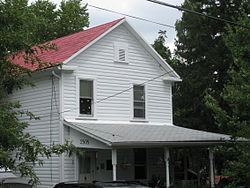NRHP Reference # 76002095 Designated NHL May 11, 1976 Opened 1920 | VLR # 000-0016 Designated VLR February 15, 1977 Added to NRHP 11 May 1976 | |
 | ||
Location 2505 1st Street, South Arlington, Virginia Similar Arlington House - The Robert E, Netherlands Carillon, Pentagon Memorial, Ballston Common Mall, Arlington National Cemetery | ||
The Charles Richard Drew House is a historic house at 2505 1st Street in Arlington, Virginia. A vernacular early 20th-century dwelling, it is of national significance as the home from 1920 to 1939 of Charles Richard Drew (1904–50), an African-American physician whose leadership on stockpiling of blood plasma saved lives during World War II. The house was declared a National Historic Landmark in 1976.
Description and history
The Drew House is located in a modest residential area in central Arlington, just northeast of the corner of 1st Street South and South Cleveland Street. It is a narrow two-story frame structure covered with wood clapboards and topped with a gabled roof. Originally a four-room house, the house was expanded with a two-room two-story addition during Drew's ownership. The house is arranged around a side stair hall, which is also the entry. From front to back the first floor comprises the living room, dining room and kitchen. Upstairs are two bedrooms and a den.
The house was home from 1920 to 1939 of Charles Richard Drew. Drew, educated at Amherst College and McGill University, conducted research in blood transfusion, and in particular the banking of blood, which was known to degenerate rapidly after removal from its donor. By the outbreak of World War II he had demonstrated that blood plasma could be stored virtually indefinitely under the proper conditions. Drew was placed in charge of a program under which blood plasma was sent to Great Britain in the early years of the war, which was continued when the United States entered the war. Drew eventually resigned from the program over racist policies enacted by the government that segregated the stockpiled blood by race. He was afterward a leading figure (at Howard University and elsewhere) in the training of a whole generation of African-American doctors.
